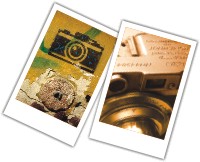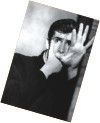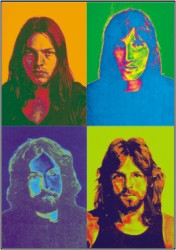
By Sabhanaz Rashid Diya and Niloy
 Weeks back, one of us was happily drooling away kacchi biriyani at a wedding when her eyes caught the digital display of the wedding photographer's camera. On any average occasion, she would have simply glanced and continued with kacchi biriyani (which, obviously is more interesting), but something about the photographer's disillusioned expression made her curious. Later, when she managed to meet up with him, she learnt how truly 'artistic' his photos could have been and how unwillingly 'boring' the photos he'll sell to the bride's family would be. There he was, quietly digesting away his passion and openly presenting his commercialism.
Weeks back, one of us was happily drooling away kacchi biriyani at a wedding when her eyes caught the digital display of the wedding photographer's camera. On any average occasion, she would have simply glanced and continued with kacchi biriyani (which, obviously is more interesting), but something about the photographer's disillusioned expression made her curious. Later, when she managed to meet up with him, she learnt how truly 'artistic' his photos could have been and how unwillingly 'boring' the photos he'll sell to the bride's family would be. There he was, quietly digesting away his passion and openly presenting his commercialism.
Photography, for many, is a lot more than just clicking away a 'stupid' camera. It's not only a silent way of capturing moments that can take away your breath, but keeping a proof of memories and places that'll bring them back years from now. It's not only a child's portrait, but an extra-ordinary motionless capture of expressions. Photography and photographers are composed of greater things than one can possibly imagine.
 Depressing and sensational as the above words may sound, it is quite a sad fact that photographers aren't given proper respect in Bangladesh. Except a handful of 'world-class' photographers, who run their own firms or are too old to be not-recognized, most aspiring photographers find it pretty difficult to get their fair share of fame. While many just decide to give up because of the cruel lack of 'future' in the field, some decide to stick with their passions and are more-or-less content with 'showing-off' to friends and family. The nicest examples of such would be the two writers of this article. Hmph.
Depressing and sensational as the above words may sound, it is quite a sad fact that photographers aren't given proper respect in Bangladesh. Except a handful of 'world-class' photographers, who run their own firms or are too old to be not-recognized, most aspiring photographers find it pretty difficult to get their fair share of fame. While many just decide to give up because of the cruel lack of 'future' in the field, some decide to stick with their passions and are more-or-less content with 'showing-off' to friends and family. The nicest examples of such would be the two writers of this article. Hmph.
What got us clicking was the unconventional beauty of reality that a simple camera can capture. None of us started with 'cool' digital cameras of 5 mega pixels. While she was experimenting with films and terrible shots, he had camera phones. The results were 'pathetic' initially, but at least one out of twenty shots couldn't resist the temptation of being 'almost perfect'. What was more important was the fact that both of us realized how amazing photography could be and why we both wanted to pursue it to higher levels. She still sucks (and still trying), but hey, he's pretty good now!
In our pursuit of a common interest, we met up with Nazzina Mohsin, who apart from working with the British Council is also an awesome female photographer. Female photographers are rarer than hot-guys-with-hot-goatees in Bangladesh and Ms. Mohsin was still struggling to keep up with her passion and workload. She offered some painful insights about the reality of being a photographer, but still encouraged young people, especially girls to step forward and simply start taking photos with whatever camera they can find. It didn't necessarily have to be an expensive digital camera - it can start from camera phones, or cheap disposable ones that your parents would like to 'dispose' of as soon as possible. Start clicking, just about anything regardless of size, colour, location or subject. Ms. Mohsin recollects how she started with a film camera of poor quality, and how a combination of practice and passion has driven her forward in photography. Her skill and effort paid of when she got the chance to work as an intern at Discovery Channel in Canada. However, she had to leave early and come back to Bangladesh; but tried to keep up with her enthusiasm towards photography by simply getting out of her house whenever she could and taking photos of anything she could find. She particularly mentioned her concern for the lack of 'artistic' landscape photography of Bangladesh and constantly urged everyone who's interested to pursue their interests at a higher level, regardless of what 'glory' (or not) it had in store for future. She, herself had turned down several offers for being a photographer for events that will conflict with her philosophies and passion and the best part is that she has no regrets. Like she said it, “It's what I love. And I won't let go of or compromise over its quality for money!” (You can check out Nazzina Mohsin's photos at framedland.com)
And that's exactly what matters most. Just like doing anything simply because you love doing it, for photography too, you'll enjoy it and get the most out of it simply if you do it out of love. It's not something you'd do to just for “easy money” or “fame”. But when you really get into it, it's beautiful. And when you see the random little kid smile with pure joy just because you pointed the camera at him and clicked the shutter, or catch a breathtaking awe-inspiring shot you feel proud about, you'll know just how amazing an experience it is to be a “guy with a camera” in Bangladesh.


By Ahsan Ksajid

 There are very few movie remakes that are able to top its predecessors. Are remakes genuine improvements on good ideas, worthy successors, or just shameless cash-ins? Some are good, some are bad, while others are absolute fecal matter! Below is a list of film remakes categorized under The Good, The Bad, and The Excrement.
There are very few movie remakes that are able to top its predecessors. Are remakes genuine improvements on good ideas, worthy successors, or just shameless cash-ins? Some are good, some are bad, while others are absolute fecal matter! Below is a list of film remakes categorized under The Good, The Bad, and The Excrement.
The Good
 Scarface: If you didn't realize that Scarface was a remake, you're not alone. It is so important to the 80s that most don't know it's a remake of a 1932 movie of the same name, inspired by Al Capone. However this Scarface casts the other Al, Al Pacino, as the Cuban drug kingpin, and his American dream gone horribly wrong. "Say hello to my little friend!" screams a gun-toting Tony Montana shortly before blasting a hole in one of the goons trying to kill him and end his drug empire. Shockingly violent (one scene involving a chainsaw is unwatchable!), it's one of the greatest crime epics, and Al Pacino delivers a character to be reckoned with, Antonio Montana.
Scarface: If you didn't realize that Scarface was a remake, you're not alone. It is so important to the 80s that most don't know it's a remake of a 1932 movie of the same name, inspired by Al Capone. However this Scarface casts the other Al, Al Pacino, as the Cuban drug kingpin, and his American dream gone horribly wrong. "Say hello to my little friend!" screams a gun-toting Tony Montana shortly before blasting a hole in one of the goons trying to kill him and end his drug empire. Shockingly violent (one scene involving a chainsaw is unwatchable!), it's one of the greatest crime epics, and Al Pacino delivers a character to be reckoned with, Antonio Montana.
Ocean's Eleven: A lot of people will agree that the original Ocean's Eleven was just an excuse for Frank Sinatra, Dean Martin, and Sammy Davis Jr. to hang out in Vegas for a few months. The remake by Steven Soderbergh however, delivers an awesome action/comedy. The original features some sensational visuals, engaging performances, and even a few songs, but little else. But the remake captures the fun of the original without sacrificing the heist itself, seamlessly combining thrills and laughs.
The Bad
 The Ring: The fact that the same guy who directed Pirates of the Caribbean remade the Japanese classic is kind of horrifying, for horror fans. The remake is not exactly lacking in it's capacity to scare the unwary, but Nakata's original is infinitely more frightening. Naomi Watts is perhaps the only reason to give the movie a try. Everyone knows the story line: a killer videotape, that kills whoever watches it within seven days. The remake's bad enough to make you avoid blockbusters for much more than seven days.
The Ring: The fact that the same guy who directed Pirates of the Caribbean remade the Japanese classic is kind of horrifying, for horror fans. The remake is not exactly lacking in it's capacity to scare the unwary, but Nakata's original is infinitely more frightening. Naomi Watts is perhaps the only reason to give the movie a try. Everyone knows the story line: a killer videotape, that kills whoever watches it within seven days. The remake's bad enough to make you avoid blockbusters for much more than seven days.
Planet Of The Apes: Tim Burton insists that his movie is not a remake of the Charlton Heston classic, but a re-imagining. Tim Burton is a moviemaker of great caliber, when he makes his own movies. This was a wasted opportunity. It had a muddled script that made little sense and really bad acting by Mark Wahlberg. The only thing worth watching the movie for was the amazing monkey make-up, all though Helena Bonham Carter under a chimp mask is just a… waste.
The Excrement
Psycho: Did this really come as a surprise, the remake of Psycho being under The Excrement? It takes something short of almighty to improve on genius. Van Sant's remake should excite lynch mobs to be formed and his home to be burned down. It didn't happen though. The real trouble lies in the imitation of every single scene, line and camera angle. The curious thing is that while Hitchcock's film looks as fresh as ever, the remake looks dated and old.
There is just one movie under The Excrement because, isn't one movie bad enough? You really want two? Maybe if you're one of those people who like to stop at car accidents to make fun of the driver's shoddy driving skills. You may not agree with the choices on the list. Feel free to drop a line.
Reference: www.imdb.com, www.rottentomatoes.com and www.askmen.com

By Tareq Adnan
 Music is all about experimentation and diversity, so this week, it'll be a genre known for those things. Progressive rock is known for veering away from traditional avant-garde style of metal. It all started with psychedelic rock in the 60s and through experimentation and fusion of genres such as blues and jazz progressive rock was born.
Music is all about experimentation and diversity, so this week, it'll be a genre known for those things. Progressive rock is known for veering away from traditional avant-garde style of metal. It all started with psychedelic rock in the 60s and through experimentation and fusion of genres such as blues and jazz progressive rock was born.
The music tends to be more elaborate and intricate and puts a lot of emphasis on structure and style. In general the songs always tend to be longer that the normal rock compositions, often being labeled as ballads. One certain style is when the song starts of with soft spoken verses that slowly become louder as the song progresses. Another is extended instrumental pieces in the songs that are based on classical music. Unlike rock music progressive rock also takes in different instruments, sort of creating a Rock Orchestra.
Most progressive rock albums are conceptual in the sense that the whole album and the songs within it follow a certain concept or theme. And the conceptual part of the albums didn't just stop at music, elaborate album art; theatrical concerts and even movies in the case of Pink Floyd's The Wall series were included as well. And the music was always based on technical advancements, the artists all experimenting with keyboards and synthesizers giving the music an almost techno rock feel.
The popularity of progressive rock slowly grew throughout the 60s and into the early 70s. In the early 60s progressive rock was more confined to jazz-fusion, artists like Mahavishnu gaining popularity in that certain sect. But slowly more and more artists started to break through into the mainstream including bands like Renaissance, Electric Light Orchestra, etc. The popularity level reached its peak in the mid 70s, riding on the success of artists like Pink Floyd, King Crimson. Albums continued topping charts for example Mike Oldfields Tubular Bells.
 However after the mid-70s the biggest artists like King Crimson, Yes, Genesis took a hiatus from the genre as the more aggressive punk rock genre broke into the mainstream. Audiences started to go towards the simpler more aggressive genre and the artists catered to popular wants and experimentation started to decline. Progressive rock started to become criticized as overblown and over hyped, too intricate as popularity fell. Popular bands such as Pink Floyd and Rush stilled scored hits but there was a definitive muted feel to it. As punk rock transcended into the new wave genre Pink Floyd released the album The Wall, a hugely successful endeavor that renewed interest in the progressive side of things.
However after the mid-70s the biggest artists like King Crimson, Yes, Genesis took a hiatus from the genre as the more aggressive punk rock genre broke into the mainstream. Audiences started to go towards the simpler more aggressive genre and the artists catered to popular wants and experimentation started to decline. Progressive rock started to become criticized as overblown and over hyped, too intricate as popularity fell. Popular bands such as Pink Floyd and Rush stilled scored hits but there was a definitive muted feel to it. As punk rock transcended into the new wave genre Pink Floyd released the album The Wall, a hugely successful endeavor that renewed interest in the progressive side of things.
The genre was revived in the 80s under the tag of neo-progressive. Although based on the 70s influences of progressive rock, this certain genre had elements of new wave as well meshed into the music. Digital synthesizers gave the music more and more an electronic feel.
Lately, progressive metal has come onto the scene, which mixes traditional systems of lengthy, instrumental tracks mixed with powerful, loud music, creating an altogether metal feel to the genre. Bands like Symphony X, Dream Theater have gained popularity through experimenting and pioneering this genre, although the influence of Rush, pioneer hard rockers are still there.
As more and more people start to get into music, creativity is flourishing. The roiling 60s and the rebellious 70s gave way to a whole different kind of music that spoke the people. Even today, experimentation is taking music to whole different levels and the future only holds more of it.
Source: Wikipedia
